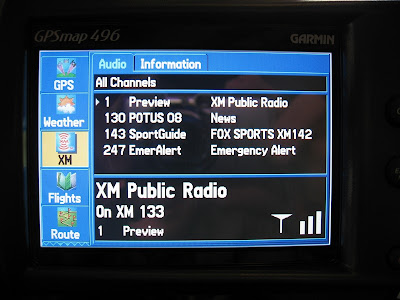Saturday, a friend and I went hiking in the West Fork of Oak Creek wilderness area. Its about 15 miles north of Sedona, AZ and is a great hike. Since its so easy to get it, it gets crowded during the day, but if you leave at daybreak you have the trail to yourself. Normally we fly into Sedona, but since the plane is down, we had to drive up. Note to self: Get RV-4 back in the air!!

The RV-4 has manual pitch trim, but we want to convert it to electric pitch trim. Since Vertical Power included a 25 ft 5 wire cable for pitch trim in the wiring harness and I had the floor removed for the remote magnetometer installation, I decide to go ahead and wire the electric pitch trim cable up and run it to the tail so it will be an easy electrical hookup in the future when we convert the trim system to electric.

The 5 wires go into the connector J6 on the control unit. 3 wires on the top row and 2 wires directly underneath them on the bottom row.

The Dynon EFIS Outside Air Temperature Probe (OAT) is installed to the remote magnetometer. This means if you put the remote magnetometer in the tail, the OAT needs to go somewhere close to it. I decided to put the OAT probe under the horizontal stabilizer. It should be out of the sun and hopefully not get any of the engine exhaust.
Dynon does sell an OAT that connects to the EMS instead of the remote magnetometer. I originally was planning on putting the OAT under my left wing about half way out in an access panel. With the EMS OAT, I could have did it. However, until the release of the latest firmware, the EFIS couldnt use the EMS OAT for all of its functions. Now I think either OAT works great with the EFIS if you have the Dynon Smart Avionics Bus hooked up.

The wiring harness for the remote magnetometer comes with the D sub pins already connected.
The blue wire and the ground wire from the OAT probe has to connect to the white ground wire that goes into pin 1 of the remote magnetometer connector. The picture below shows how I hooked them together. I removed the insulation from part of the ground wire on the remote
magnetometer cable that comes from the Dynon EFIS.

After stripping back the insulation in the OAT cable, I used a pick to remove the red, yellow and blue wires from the shielding without damaging it.

The blue wire and the ground wire from the OAT is then soldered onto the ground wire from the EFIS and shink wrap put around it to protect it.
Here is a picture of the complete connector.

I had to build a bracket to hold the remote magnetometer in the fuselage where it is away from any metals that may interfere with it. This turned into a major pain because I decided to put in the the rear of the fuselage. The bulkhead is about 1/2 the width of my body. It a real tight fit and then my arms wouldnt be in the right position to do what I wanted so I would have to squirm out and turn over or on my side and try from a different angle. The remote magnetometer is supposed to be within 1 degree on all three axis of what the Dynon EFIS is at.
I was able to get this with the help of a smart level but it sure was a lot of work. It took about 10 hours to do everything. Here is a picture of the installation. What the picture doesnt show is that my OAT is not working so I will have to go in tomorrow and take the connector apart and see if I have something wrong in the connector.

The plan was to get the remote magnetometer installed and button everything up and go flying today. I severely underestimated how long it take to install the remote magnetometer and the OAT.

















































